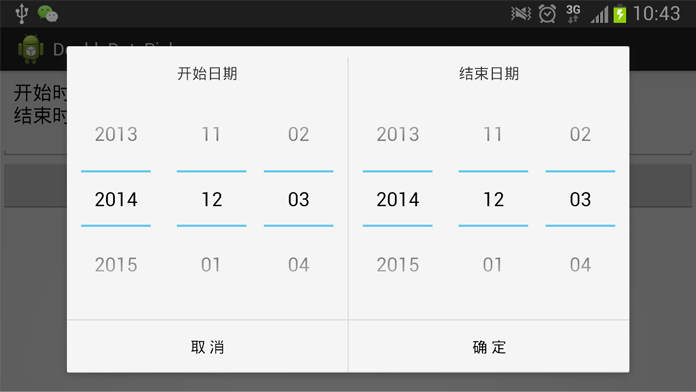編輯:關於Android編程
一、保存文件到手機內存
/**
* 保存數據到手機rom的文件裡面.
* @param context 應用程序的上下文 提供環境
* @param name 用戶名
* @param password 密碼
* @throws Exception
*/
public static void saveToRom(Context context, String name , String password) throws Exception{
//File file = new File("/data/data/com.itheima.login/files/info.txt");
File file = new File(context.getFilesDir(),"info.txt");//該文件在data下的files文件夾下getCacheDir()在cache文件夾下 文件大小不要超過1Mb
FileOutputStream fos = new FileOutputStream(file);
String txt = name+":"+password;
fos.write(txt.getBytes());
fos.flush();
fos.close();
}
/**
* 獲取保存的數據
* @param context
* @return
*/
public static Map<String,String> getUserInfo(Context context) {
File file = new File(context.getFilesDir(),"info.txt");
try {
FileInputStream fis = new FileInputStream(file);
//也可直接讀取文件String result = StreamTools.readFromStream(fis);
BufferedReader br = new BufferedReader(new InputStreamReader(fis));
String str = br.readLine();
String[] infos = str.split(":");
Map<String,String> map = new HashMap<String, String>();
map.put("username", infos[0]);
map.put("password", infos[1]);
return map;
} catch(Exception e) {
e.printStackTrace();
return null;
}
}
//最後可以直接調用上面的方法讀取信息
Map<String, String> map = getUserInfo(this);
If(map!=null){
Textview.setText(map.get(“username”));
}
二、保存文件到SD卡
獲取手機sd空間的大小:
File path = Environment.getExternalStorageDirectory();
StatFs stat = new StatFs(path.getPath());
long blockSize = stat.getBlockSize();
long totalBlocks = stat.getBlockCount();
long availableBlocks = stat.getAvailableBlocks();
long totalSize = blockSize*totalBlocks;
long availSize = blockSize * availableBlocks;
String totalStr = Formatter.formatFileSize(this,totalSize);
String availStr = Formatter.formatFileSize(this, availSize);
tv.setText("總空間"+totalStr+"\n"+"可用空間"+availStr);
加入寫外部存儲的權限:
<uses-permission android:name="android.permission.WRITE_EXTERNAL_STORAGE"/>
public static void save(String name ,String password) throws Exception{
if (Environment.getExternalStorageState().equals(Environment.MEDIA_MOUNTED)){
File file = new File(Environment.getExternalStorageDirectory(),"info.txt");
//也可直接寫/sdcard/info.txt 先判斷sd卡是否存在
FileOutputStream fos = new FileOutputStream(file);
String txt = name+":"+password;
fos.write(txt.getBytes());
fos.flush();
fos.close();
// 使用RandomAccessFile像文件追加內容FileOutputStream會把原有的文件內容清空
//RandomAccessFile raf = new RandomAccessFile(file,"rw");
//raf.seek(file.length()); 將文件指針移動到最後
//raf.write(name.getBytes()+password.getBytes());
//raf.close();
}
}
//讀取文件 加入讀取權限
public static String read(){
try {
if (Environment.getExternalStorageState().equals(Environment.MEDIA_MOUNTED)){
File sdcardDir = Environment.getExternalStorageDirectory();
FileInputStream fis = new FileInputStream(sdcardDir.getCanonicalPath() + "info.txt");
BufferedReader br = new BufferedReader(new InputStreamReader(fis));
StringBuilder sb = new StringBuilder("");
String line = null;
while ((line = br.readLine())!= null){
sb.append(line);
}
return sb.toString();
}
} catch (Exception e) {
e.printStackTrace();
}
return null;
}
三、Sharedpreferences的使用
SharedPreference是開發中常用的一種存儲方式,主要存儲一些系統不變的參數如是否是第一次進入應用程序等,通過鍵值對的方式進行存儲
可以存儲的類型:booleans, floats, ints, longs,strings.
getSharedPreferences() - 存儲多個參數
getPreferences() - 僅存儲一個參數並且不需要指定名字(key)
寫入的步驟:
SharedPreferences調用edit()得到一個Editor對象
使用 putBoolean() and putString()添加值
提交事務完成存儲
讀取時:只需要調用SharedPreferences的getBoolean() and getString()
下面是示例代碼:
public class MySharedPreference {
private Context context;
private SharedPreferences sp ;
private Editor edit;
public MySharedPreference(Context context){
this.context = context;
}
public boolean saveMessage(String name,String pwd){
boolean flag = false;
sp = context.getSharedPreferences("userInfo",Context.MODE_PRIVATE);
//MODE定義了訪問的權限現在是本應用可以訪問
edit = sp.edit();
edit.putString("name", name);
edit.putString("pwd", pwd);
flag = edit.commit();//提交事務將數據持久化到存儲器中
return flag;
}
public Map<String,Object> getMessage(){
Map<String,Object> map = new HashMap<String, Object>();
sp = context.getSharedPreferences("userInfo", Context.MODE_PRIVATE);
String name = sp.getString("name", "");
String pwd = sp.getString("pwd", "");
map.put("name", name);
map.put("pwd",pwd);
return map;
}
}
 android實現雙日期選擇控件(可隱藏日,只顯示年月)
android實現雙日期選擇控件(可隱藏日,只顯示年月)
在安卓開發中,會碰到選開始日期和結束日期的問題。特別是在使用Pad時,如果彈出一個Dialog,能夠同時選擇開始日期和結束日期,那將是極好的。我在開發中在DatePick
 Android UI基礎——五大布局
Android UI基礎——五大布局
一個豐富的界面是由很多個控件組成的,如何讓各個控件都有條不紊的擺放在介面上,這就需要布局來實現了,布局可以說是一種容器,可以按照一定規律調整控件的位置,布局之內也可以放置
 Android自定義View實現鐘擺效果進度條PendulumView
Android自定義View實現鐘擺效果進度條PendulumView
在網上看到了一個IOS組件PendulumView,實現了鐘擺的動畫效果。由於原生的進度條確實是不好看,所以想可以自定義View實現這樣的效果,以後也可以用於加載頁面的進
 Android基礎入門教程——8.3.4 Paint API之—— Xfermode與PorterDuff詳解(一)
Android基礎入門教程——8.3.4 Paint API之—— Xfermode與PorterDuff詳解(一)
本節引言: 不知道標題這兩個玩意你熟不熟悉啦,如果自己實現過圓角或者圓形圖片,相信對這兩個名詞 並不模式,一時半伙沒想起來?沒關系,下面這個圖你可曾見過?